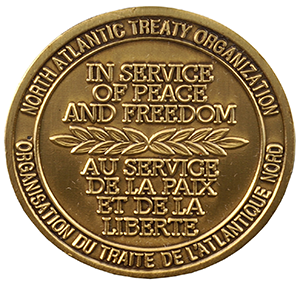Non-Article 5 NATO Medal for Operations in the Balkans
The official description, eligibility, criteria, and history of the Non-Article 5 NATO Medal for Operations in the Balkans.



Context
On 14 December 1995, the North Atlantic Council launched Operation JOINT ENDEAVOUR, the largest military operation ever undertaken by the Alliance. Based on UN Security Council Resolution 1031, NATO was given the mandate to implement the military aspects of the Peace Agreement. A NATO-led multinational force, called the Implementation Force (IFOR), started its mission on 20 December 1995. IFOR was given a one-year mandate.
After the peaceful conduct of the September 1996 elections, IFOR successfully completed its mission of implementing the military annexes of the General Framework Agreement for Peace. However, it was clear that much remained to be accomplished on the civil side and that the political environment would continue to be potentially unstable and insecure. On 25 & 26 September, one week after the Bosnian elections, NATO Defence Ministers concluded that the Alliance needed to re-assess how it might continue to provide support for the establishment of a secure environment after the end of IFOR's mandate in December. The role of IFOR (Operation JOINT ENDEAVOUR) was to implement the peace. The role of SFOR (Operation JOINT GUARD / Operation JOINT FORGE) is to stabilise the peace. The difference between the tasks of IFOR and SFOR is reflected in their names.
On 12 December 1996, SFOR was authorised to implement the military aspects of the Peace Agreement as the legal successor to IFOR. Like IFOR, SFOR operates under Chapter VII of the UN Charter (peace enforcement).
Eligibility and criteria
Awarded for 30 days continuous or 60 days cumulative service on the land or in the air spaces of Bosnia-Herzegovina, Croatia, the Former Yugoslavia (including Kosovo), Albania, and the Former Republic of Macedonia, between 1 January 2003 and ending on 29 March 2010 for service under Operation BRONZE.
Service under Operation KOBOLD qualifies for this medal from August 2008 to the present.
Aircrew will accumulate one day’s service for the first sortie flown of any day in the Area of Operation; additional sorties flown on the same day receive no further credit. This requirement exists for support as well as combat aircraft, and support aircraft including tanker, airlift, and surveillance platforms.
NATO strictly applies their medals policy and will not consider requests for initial issue of NATO medals that are submitted more than two years after repatriation from mission area.
NATO Regulations state that any person who dies or is evacuated because of injuries of medical reasons directly attributable to service is deemed to have satisfied the time criteria.
Description
The Medal is circular in form and made of bronze, and bearing:
- on the obverse, the NATO star set in a wreath of olive leaves; and
- on the reverse, the title "NORTH ATLANTIC TREATY ORGANIZATION" and the words "IN SERVICE OF PEACE AND FREEDOM" in English and French.
A 12mm bronze ring, which holds the ribbon, passes through a small hollow ball at the top of a claw joined to the top of the medal.
Medals issued until 31 December 2010 had a NATO-blue ribbon with a central white stripe upon which is superimposed a silver stripe, while those issued from 1 January 2011 onwards have a NATO-blue ribbon with two white stripes centred on the two outer thirds of the ribbon, with a silver stripe in the centre of each white stripe. The white represents peace and the silver signifies that the operation was ordered in accordance with another article than Article 5 of the North Atlantic Treaty.
Bar(s)
The medal is always issued with a bar. Medals issued until 31 December 2010 had a bar inscribed "NON ARTICLE 5" while those issued from 1 January 2011 onwards have a bar inscribed "BALKANS".
Wearing
The medal shall be worn on the left breast, suspended from the ribbon described above, after the NATO Article 5 Medal for OP ACTIVE ENDEAVOUR and before the Non-Article 5 Medal for service with the NATO Training Implementation Mission and the NATO Training Mission in Iraq (NTM-IRAQ) in the sequence prescribed by the Canadian Orders, Decorations and Medals Directive.
The bar is worn centered on the ribbon.
Post-nominals
The use of a post-nominal is not authorized for this medal.
Historical notes
This medal replaces the NATO medals for Former-Yugoslavia, Kosovo, and the Former Yugoslav Republic of Macedonia.
NATO no longer recognizes service in support areas such as Italy, Greece, Hungary, and Austria as qualifying time towards the Non-Article 5 Medal. A member must serve thirty days in the theatre of operations to qualify for the medal.
The following is a list of members who have died while serving in the theatre of operations:
- Cpl Vermeulen J.D.
- Pte Johnson A.D.
- PO 2 Morissette J.S.
The medal is accompanied by a certificate.